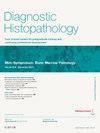Metastatic neuroendocrine tumour of the orbit
引用次数: 0
Abstract
A 64-year-old patient presented with a tumour of the orbit. A biopsy showed an infiltrative tumour with coarse “salt-and-pepper” chromatin, showing strong expression of AE1/3, CD56, synaptophysin, chromogranin, and CDX2 on immunohistochemistry. The Ki67 proliferation index was low (<1%). The diagnosis of metastatic neuroendocrine tumour, most likely of gastrointestinal origin was favoured over a primary neuroendocrine tumour of the orbit.
眼眶转移性神经内分泌肿瘤
一名 64 岁的患者因眼眶肿瘤就诊。活检显示肿瘤呈浸润性,染色质粗糙,免疫组化显示 AE1/3、CD56、突触素、嗜铬粒蛋白和 CDX2 表达较强。Ki67增殖指数较低(1%)。与眼眶原发性神经内分泌肿瘤相比,转移性神经内分泌肿瘤(很可能源于胃肠道)的诊断更受青睐。
本文章由计算机程序翻译,如有差异,请以英文原文为准。
求助全文
约1分钟内获得全文
求助全文
来源期刊

Diagnostic Histopathology
Medicine-Pathology and Forensic Medicine
CiteScore
1.30
自引率
0.00%
发文量
64
期刊介绍:
This monthly review journal aims to provide the practising diagnostic pathologist and trainee pathologist with up-to-date reviews on histopathology and cytology and related technical advances. Each issue contains invited articles on a variety of topics from experts in the field and includes a mini-symposium exploring one subject in greater depth. Articles consist of system-based, disease-based reviews and advances in technology. They update the readers on day-to-day diagnostic work and keep them informed of important new developments. An additional feature is the short section devoted to hypotheses; these have been refereed. There is also a correspondence section.
 求助内容:
求助内容: 应助结果提醒方式:
应助结果提醒方式:


